
* The MiG-25 emerged from Cold War tensions. During the 1950s and early 1960s, the US built up a force of heavy bombers that could destroy the USSR with nuclear weapons, and so the Soviets put great effort into developing defensive systems, the Foxbat being high on the list, to defend their nation over its vast frontiers. The MiG-25 in turn would cause the Americans to fear that they were being outpaced by Soviet fighter design, leading to the development of a new generation of US fighters.
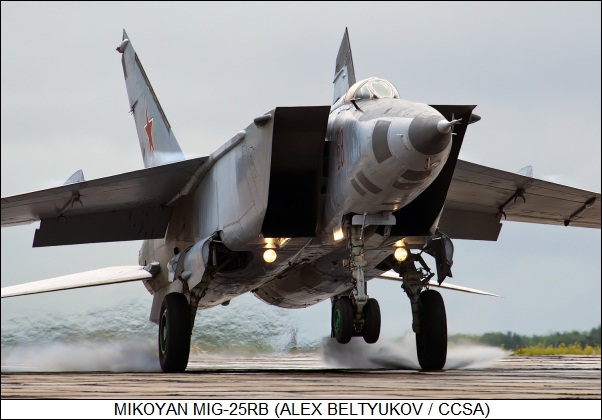
* The MiG-25 ironically owed its origins to American aircraft development programs. In the late 1950s, the US fielded the General Dynamics B-58 Hustler Mach 2 bomber, and began development of the North American B-70 Valkyrie bomber, which was designed to penetrate Soviet airspace at high altitude and Mach 3 speeds. The USSR had nothing that could deal with such threats. Since homeland defense was a top Soviet priority, little expense was spared to develop an interceptor with long range, high performance, and advanced air-to-air missiles (AAM) to deal with the B-58 and B-70.
In 1961, the Mikoyan OKB (experimental design bureau) was well along in design work for such a high-performance interceptor -- initially focusing on what amounted to scaled-up versions of the OKB's MiG-21 fighter, and flying prototypes of such aircraft with the designations of "I-75", "Ye-150", and "Ye-152" -- when the US reduced the B-70 effort to a purely experimental program. Intercontinental ballistic missiles (ICBMs) on one hand, and steadily improving defensive surface-to-air missiles (SAMs) on the other, had rendered the notion of a high-altitude piloted bomber obsolete.
The work at the Mikoyan OKB continued, however, as a countermeasure against American development of a high-speed high-altitude reconnaissance aircraft that could overfly the USSR, which emerged as the Lockheed "SR-71 Blackbird". The Soviets had been infuriated by reconnaissance overflights of Lockheed U-2 spyplanes in the late 1950s and were willing to go to substantial lengths to shoot down intruders -- though by the early 1960s, both sides were developing reconnaissance satellites that would eliminate most of the need for aerial overflights.
The Soviets also saw the new MiG interceptor as the basis for a high-speed reconnaissance aircraft of their own. In addition, there were design concepts for derivatives for the conventional strike and strategic nuclear attack roles; variants with variable geometry ("swing wings") for low-speed maneuverability, or lift-jets for short take-off; a strategic cruise missile carrier; and even a 5-to-7 seat supersonic airliner; but these alternate ideas came to nothing.
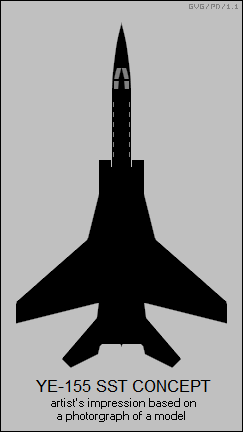
Development of the "Ye-155P" (where "P" stood for "perekhvatchik / interceptor") and "Ye-155R" (where "R" stood for "razvedchik / reconnaissance") had been formally approved in February 1961, with prototype construction authorized a year later. System elements were flight-tested on a variety of platforms, including a MiG-21, a Tupolev Tu-16 bomber, plus Tu-104 and Tu-110 airliners.
Two prototypes were built of the reconnaissance variant, with the two designated the "Ye-155R-1" and "Ye-155R-2". The Ye-155R-1 performed its maiden flight on 6 March 1964, with test pilot Alexander Fedotov at the controls. Two prototypes were also built of the interceptor variant and designated "Ye-155P-1" and "Ye-155P-2". The Ye-155P-1 performed its maiden flight on 9 September 1964, with test pilot Piotr Ostapenko at the controls.
All four of these initial prototypes were built in the MiG OKB's workshops. They were followed by four preproduction reconnaissance machines (including one ground-test aircraft), designated "Ye-155R-3" through "Ye-155R-6"; and nine preproduction interceptors, designated "Ye-155P-3" through "Ye-155P-11". The four reconnaissance machines were built at a factory in Gorkiy, now Nizhny Novgorod, while the nine interceptors were built in the MiG OKB workshops. At least two of the Ye-155Ps were lost in accidents.
* The Ye-155R-1, Ye-155R-3, and Ye-155P-1 prototypes were used for a number of highly successful attempts to break world aircraft performance records in 1965, 1967, and 1973. They were given the cover designation of "Ye-266". The accomplishments of these machines included a 1967 1,000 kilometer close-circuit speed record of 2,920.67 KPH (1,814.87 MPH); and 1973 records for a climb to 30,000 meters (98,400 feet) of 4 minutes 3.86 seconds, plus an absolute altitude record of 36,240 meters (118,900 feet). Fedotov set the altitude record, executing a zoom climb until the engines flamed out, and then coasting up and over to the top of the arc. One suspects that the aircraft was flying with all the aerodynamic grace of a brick at that point. Once the machine fell back to lower altitude, he regained control and relit the engines.
Both the reconnaissance and interceptor variants of the Ye-155 entered production in 1969, as the "MiG-25R" and "MiG-25P" respectively. The MiG-25R entered service with the Soviet air force, the VVS, in 1969, and the MiG-25P formally entered first-line service with the Soviet national air defense force, the PVO, in 1972. All production MiG-25s would be built at the factory in Gorkiy.
BACK_TO_TOP* Building a high-performance interceptor like the MiG-25P was a major challenge. Getting a big aircraft with large fuel capacity up to such speed implied advanced aerodynamics and engines, and keeping it at that speed implied the ability to tolerate high temperatures caused by air friction. Finding and destroying a high-speed intruder dictated powerful radar, along with long-range, hard-hitting AAMs.
The MiG-25P design that emerged had little obviously in common with the experimental scaled-up MiG-21 designs that had preceded it. The MiG-25P actually seemed to be more influenced by the pioneering US North American A-5 Vigilante shipboard strike and reconnaissance aircraft. Like the Vigilante, the MiG-25P had twin engines on each side of the fuselage, with wedge-style engine intakes featuring variable inlets using hinged ramps; thin, high-mounted swept wings; an all-moving tailplane; and a clamshell canopy between the inlets, with a nonexistent rearward view. The cockpit was pressurized, though pilots still generally wore full pressure suits for high-altitude operations. A KM-1 ejection seat was fitted initially, though it would be replaced after early production by the much better KM-1M.
Calling it a Vigilante copy would be false, however, since the MiG-25P was completely different in detail and distinctive in appearance, being more slab-sided and businesslike than the A-5. The MiG-25P also featured twin tailfins, each fitted with a rudder and canted outward 11 degrees, making it one of the first operational aircraft with such a feature. Twin tailfins had been considered for the Vigilante, but it had seemed like too much of an innovation at the time, even though the A-5's tall tailfin had to be hinged to fit the aircraft into a carrier hangar deck. Ironically, a single tailfin had been considered early in the Ye-155 program. The twin tailfins would find their way back into American designs like the McDonnell Douglas F-15 Eagle. The MiG-25P also had twin fixed ventral fins, another item that became popular in Western aircraft.
The MiG-25P's wings had a 5-degree anhedral droop. They did not have a constant sweep, though the change in sweep was hard to notice, with a sweepback of 42.5 degrees inboard and 41 degrees outboard. Each wing featured a simple flap inboard and a two-section aileron outboard, plus two, distinctively Soviet, wing fences on top. Some sources claim early machines had "blown" flaps to reduce take-off run. There was an airbrake on top of and below the rear fuselage.
The wings were "wet", containing substantial fuel tankage. The slab-sided appearance of the fuselage undoubtedly had something to do with the fact that 70% of the aircraft's internal volume was occupied by fuel tanks, giving the MiG-25 a total internal fuel capacity of 17,660 liters (4,666 US gallons). It had a single-point refueling system.
Despite the MiG-25's high operating temperature at combat flight speed, only 8% of the airframe was made of titanium. 80% was made of tempered steel, while most of the rest, 11%, was made of aircraft aluminum alloys. The design featured dual hydraulic systems for flight controls and landing gear; a high-power electrical system to drive radar and other systems; plus extensive cooling and insulation to protect internal systems and the pilot. Developing temperature-resistant materials, such as paint, hydraulic fluids, canopy panels, and tire rubber, was a major design challenge.
The MiG-25 had typical Soviet heavy-duty landing gear in tricycle configuration, with twin-wheel steerable nose gear retracting forward into the nose, and large single-wheel main gear retracting forward into the fuselage. The nose gear was mounted just underneath the inlets, far enough back to reduce the risk of foreign-object ingestion. The landing gear had pneumatically-operated antilock brakes. The MiG-25 used two brake parachutes to reduce its landing roll, deploying either conical or cruciform parachutes. The brake chutes were stowed in a small tailcone above the engine exhausts, and were deployed automatically on touchdown. A single chute was used early on, but tended to drag on the ground and was replaced by the dual chutes in 1977.
The initial prototype Ye-155R-1 had a number of differences from production MiG-25s, including a wing with no anhedral, which led to yaw and roll instability; shorter tailfins; bigger ventral fins, which scraped the runway; and wingtip fuel tanks with winglets, which led to flight stability problems. The second prototype Ye-155R-2 had triangular wing endplates as a temporary fix for the lack of wing anhedral. The triangular endplates, which had a tacked-on appearance, were referred to by development engineers as "webbed feet".
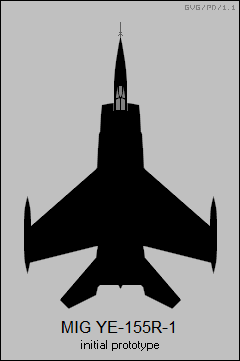
The webbed feet were featured in some of the preproduction interceptor machines, even though they had limited wing anhedral. The endplate fins were also fitted to some very early production MiG-25Ps, along with the shorter tailfins and longer ventral fins.
The initial production MiG-25P, which acquired the NATO reporting name of "Foxbat-A", was fitted with two big Tumanskiy (earlier Mikulin) R-15B-300 afterburning turbojets with 100 kN (10,205 kgp / 22,500 lbf) afterburning thrust each. A water-methanol "mass injection" system was fitted for boost thrust. Engine fire-extinguishing systems were fitted, and there was a firewall between the engines to prevent the failure of one from crippling the other.
Armament consisted of four big R40 (NATO AA-6 Acrid) AAMs, one of the largest AAMs ever built, on underwing pylons. Usually a mix of two R-40R semi-active radar homing (SARH) AAMs and two R-40T heat-seeking AAMs was carried. No cannon armament was fitted.
Although the MiG-25P was directed to a target area under ground control, it still required a powerful radar to find and illuminate targets for the long-range R-40R AAMs, and so the MiG-25P was fitted with the RP-25 Smerch-A1 (Whirlwind-A1 / NATO Fox Fire) radar, derived from the RP-S radar used on the MiG-25P's predecessor, the oversized Tupolev Tu-128 "Fiddler" long-range interceptor. The Smerch-A1 had a detection range of 100 kilometers (62 miles), and a tracking range of 50 kilometers (31 miles). It was said to so powerful that it would fry rabbits sitting at the edge of the runway and had to be kept turned off until the aircraft was well clear of the ground -- though such tales appear to be exaggerations.
In any case, the Smerch-A1 was powerful enough to "burn through" jamming countermeasures. It was not very sophisticated, lacking the "look down" capability needed to find low-flying targets hiding in ground clutter; the Soviets hadn't developed an operational pulse-Doppler radar at that time to perform that trick. They conformed to their usual pragmatic design philosophy of running with what they had instead of waiting for something better, and continued to work on improvements. Later MiG-25P production featured modestly improved Smerch-A2 and then Smerch-A3 radars, which still lacked a look-down capability.
Other avionics included a Polyot 1L inertial navigation system (INS), working in conjunction with radio navigation aids; a Sirena S-3M radar warning system (RWR); HF and UHF radios; identification friend or foe (IFF) transponder system; low and high altitude radar altimeters; and a cockpit voice recorder. A MiG-25P would be directed to a target area automatically, with ground controllers using the aircraft's Vozdookh 1 and Lazur radio links. The links were integrated into the aircraft's Polyot 1L INS, making the MiG-25P effectively a "manned missile". This approach fit the Soviet inclination towards "ground controlled intercept (GCI)", and also eliminated the need for a back-seater to operate radar and navigation systems.
In service, MiG-25s flew in natural metal or overall gray markings, though a small number of them operating in East Germany were painted in rough green-tan camouflage colors. This scheme was known in the West as an "Afghanistan scheme", since it was much like that applied to Soviet aircraft operating in the 1980s Afghanistan War -- though the MiG-25 itself saw little or no action in that conflict.
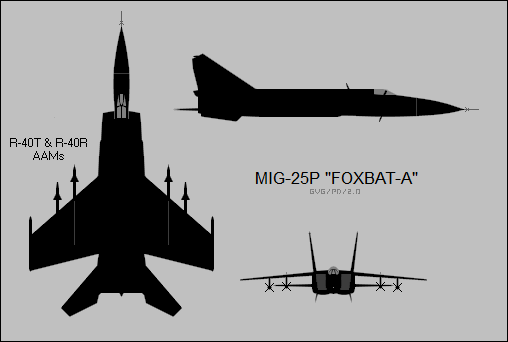
* The MiG-25 was pushing the limits, and in fact it wasn't until 1973 that the MiG-25P finally entered frontline service. There had been severe teething problems, particularly with the Tumanskiy turbojets, which initially had a rated operational lifetime of only 150 hours. The limited lifetime was partly because the engine had originally been designed for a single-engine Mach 2+ reconnaissance drone, the Tupolev Tu-123 Yastreb (Hawk); the drone being expendable, there had been no need to design the engine for long life. The engine was extensively redesigned for the MiG-25. The original engine had been designed to operate at constant thrust, which was unacceptable for a piloted aircraft and meant adding a throttling system and a variable nozzle, while changes were made in the compressor and combustor. However, it required still more work to bring it up to better standards of reliability. It would eventually be rated for up to 1,000 hours of operation -- unimpressive, but a great improvement.
There was consternation over the appearance of the Foxbat-A in the West, with an inclination to believe that it was superior to all Western fighter jets, even that it had Mach 3 performance. This insecurity helped drive the development of next-generation Western fighters, such as the F-15 Eagle. In reality, the MiG-25P did not come close to meeting its range specification, and could not be flown at Mach 3+ for any length of time.
On 6 September 1976, a disaffected Red Air Force pilot named Viktor Belenko made headlines when he flew his Foxbat-A from Siberia to Japan, landing at Hakodate. He was taken in by the Americans, obtaining a trust fund and, eventually, American citizenship. Belenko said that the redline speed of his Foxbat-A was Mach 2.5, adding that at speeds of Mach 2.8 or more, the engines tended to run out of control and burn up. There were tales in the West that Foxbats that did fly at Mach 3+ for an extended period needed an engine swap when they came back down.
Assessment of Belenko's MiG-25P also suggested that the type was not very maneuverable -- though as an interceptor designed to operate under ground control, it really wasn't supposed to be. There was sniping about the fact that the airframe didn't use flush riveting, leaving draggy rivet heads in the airflow, though as it turned out rivets were only used in areas where they wouldn't affect performance. The fact that the Smerch-A1 radar was also heavily based on vacuum-tube instead of solid-state technology also led to some criticisms. However, many microwave engineers insist even now that vacuum-tube technology is perfectly practical and cost-effective for high-power microwave applications, though it is clear that the Smerch-A1 lacked the "smarts" of the most sophisticated contemporary Western radars.
The MiG-25 also had some clear virtues from the outset. It was representative of Soviet design philosophy, being relatively cheap to build, rugged, reliable, easy to maintain, and straightforward to operate. Surprisingly, given that the MiG-25 was a big step up in performance for Soviet pilots, it had a very good flight safety record. The SR-71 was faster and capable of flying at higher altitudes -- the MiG-25 was really more in a league with the later US F-15 in terms of performance -- but the Blackbird was expensive, as well as demanding to maintain and fly.
Incidentally, after analysis of Belenko's Foxbat-A, it was dismantled and shipped back to the USSR. To no surprise, the Soviet government had loudly demanded the return of the aircraft; the Japanese government was perfectly agreeable to do so -- but in a very Japanese fashion, one minor issue after another came up, each requiring discussion and clarification between the Russians and Japanese, that delayed return of the aircraft until the analysis of the aircraft was complete. The analysis had been aided by the fact that Belenko made sure he had packed all the tech manuals he could get his hands on with him when he flew off to Japan. Belenko ended up with a career with the US Air Force as an expert on Soviet air power.
BACK_TO_TOP* The MiG-25P still needed some work, and with Belenko's defection its radar and other systems had been badly compromised. As a result, in November 1976 the MiG OKB was ordered to develop an improved MiG-25P on a fast-track basis. The new variant was designated "MiG-25PD", where the "D" stood for "dorabottanniy / upgraded". The MiG-25PD was introduced into service in 1979 and assigned the NATO reporting name of "Foxbat-E".
The most significant improvement in the MiG-25PD was the new RP-25M Saphir 25 radar, based on the Saphir-23 developed for the MiG-23 fighter. It was a great improvement over the Smerch-A, having slightly greater range and, more significantly, pulse-Doppler operation to provide a look-down / shoot-down capability. The aircraft's nose was slightly stretched to accommodate the new radar. The Saphir 25 was complemented in later MiG-25PD production by a TP-26Sh-1 "infrared search & track (IRST)" sensor mounted under the nose to provide passive target detection and tracking.
There had been upgrades in other avionics systems during MiG-25P production, and the MiG-25PD was fitted with the most up-to-date standard of radios, navigation systems, datalinks, and IFF. It also could carry improved R-40R and R-40T AAMs, featuring more sophisticated seekers, these updated weapons being designated "R-40RD" and "R-40TD" respectively. In addition, the MiG-25PD could carry an alternate warload of two R-40s and four R-60 (NATO AA-8 Aphid) short-range heatseeking AAMs, with the Aphids replacing the outboard R-40s and carried on a dual stores rack.
Other improvements in the MiG-25PD included R15BD-300 engines, with no increase in thrust but modernized accessory gearboxes; and the ability to carry an oversized, spindle-shaped 5,300-liter (1,400 US gallon) belly tank, over half as long as the aircraft itself, and one of the biggest external tanks ever fitted to any Soviet aircraft.
Older MiG-25Ps were updated to a similar specification and given the new designation of "MiG-25PDS", with the "DS" standing for "dorabottanniy v stroyou / field upgrade". They were also referred to by NATO using the Foxbat-E designation.
________________________________________________________________________
MIKOYAN MIG-25PD FOXBAT-E INTERCEPTOR:
________________________________________________________________________
wingspan:
14 meters (46 feet)
wing area:
61.4 sq_meters (661 sq_feet)
length:
23.82 meters (78 feet 2 inches)
height:
6.1 meters (20 feet)
normal TO weight:
36,720 kilograms (80,952 pounds)
max speed at altitude:
3,000 KPH (1,865 MPH / 1,620 KT)
service ceiling:
20,700 meters (67,915 feet)
take-off run:
1,250 meters (4,100 feet)
range (subsonic):
1,730 kilometers (1,075 MI / 935 NMI)
range (supersonic):
1,250 kilometers (775 MI / 675 NMI)
________________________________________________________________________
In principle, a MiG-25 could intercept an SR-71 if everything went right, though the window of opportunity was narrow. It seems that improvements in SAM defenses and political considerations precluded SR-71 overflights of the USSR in any case.
BACK_TO_TOP* As mentioned, the Ye-155R-1 reconnaissance aircraft prototype flew first, and went into production in 1969 as the MiG-25R, which was given the NATO reporting name of "Foxbat-B". It featured a modified nose with five ports for Zenit film cameras, one vertical and four oblique, and a dielectric panel along each side of the nose for electronic intelligence (ELINT) system antennas. The cameras were mounted on a pallet that could be dropped out of the nose. The MiG-25R featured a Peleng automatic navigation system, possibly the first Soviet INS to go into operational flight service.
The MiG-25R had a slightly different wing configuration from the MiG-25P, with a shorter span and a straight, not slightly cranked, leading edge, featuring a sweep of 41.03 degrees. The tailfins of all but the first production examples were also longer than those of the interceptor variant, with fuel tankage incorporated into the fins, and the engine exhausts were slightly longer as well.
Even before operational introduction, four MiG-25Rs were sent to Egypt in 1971 under the cover designation of "X-500". They overflew Israel in pairs about 20 times and were never intercepted, even though Israeli intelligence generally knew when the overflights were scheduled. The MiG-25Rs went back home in 1972, though reconnaissance Foxbats were sent back to Egypt in October 1973, after the Yom Kippur War, and remained there into 1974.
It appears that the MiG-25R was only built in small numbers, since it was replaced on the production line by the "MiG-25RB" reconnaissance-bomber variant in 1970. It is a bit surprising that a bombing capability was added, since it would seem unlikely that dropping conventional bombs from very high altitude and very high speed would be particularly accurate. To provide the hoped-for precision, the Peleng navigation system was linked to radio navigation aids and a bombing computer. The MiG-25RB also carried a countermeasures jamming system.
The MiG-25RB could originally carry four FAB-500M-62T 500-kilogram (1,100-pound) bombs, carried by tandem double ejector bomb racks under the fuselage. The bombs were specially built to tolerate high temperatures. Late production MiG-25RBs could carry six FAB-500 bombs under the fuselage, using tandem triple ejector bomb racks, and also featured a stores pylon under each wing, with each pylon capable of carrying two FAB-500 bombs in tandem. That gave a total bombload of ten FAB-500s, or four FAB-500s plus the big centerline fuel tank.
The effectiveness of the MiG-25RB as a strike aircraft remains unclear. Some sources claim that the MiG-25RB could also carry a single nuclear munition instead of a conventional bomb load, which would have greatly reduced concerns about accuracy. In any case, the standard camera nose was retained, though some improvements were made in equipment fit. The MiG-25RB went into service in the 1970s, and surviving MiG-25Rs were brought up to MiG-25RB standard.
* The MiG-25RB led to several improved variants. In addition, although American reconnaissance aircraft such as the Lockheed U-2 and the SR-71 were designed to accommodate different classes of reconnaissance payloads by swapping out equipment pallets, the Soviets chose to field more or less dedicated MiG-25 reconnaissance variants for specialized reconnaissance roles:
* Along with the interceptor and reconnaissance variants, the Soviets developed a "suppression of enemy air defenses (SEAD)" variant of the MiG-25. The idea had actually been around since before the first flight of any Foxbat prototype, embodied in a "Ye-155K" proposal, to eventually emerge as the "MiG-25BM" (NATO Foxbat-F).
The USSR did not like the "up close and personal" approach of American "Wild Weasel" defense suppression aircraft and decided to adopt a "stand-off" approach. The Foxbat-F was equipped with a sophisticated Yaguar (Jaguar) "radar homing and warning system (RHAWS)", in a nose with a 20-centimeter (8-inch) extension plug and dielectric panels for receiving antennas on the sides. The MiG-25BM carried a total of four Kh-58 (NATO AS-11 Kilter) anti-radar missiles (ARMs) on its wing pylons. The Kh-58 had a range of more than 48 kilometers (30 miles), and was the first operational Soviet ARM that could be carried by a fighter-class aircraft.
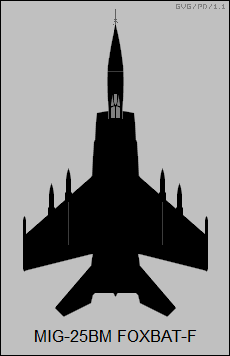
The MiG-25BM generally carried the big 5,300-liter (1,400 US gallon) centerline tank. Since the MiG-25BM was a single-seat aircraft while US Wild Weasel platforms were two-seaters, pilot workload was probably on the high side.
The initial prototype was rebuilt from a MiG-25RBV and performed its initial flight in 1976. Production of the MiG-25BM began in 1982 and continued into 1985, with about a hundred built. Most or all Foxbat-Fs featured black-painted noses as a "deception" scheme to make them look like interceptors in surveillance satellite images.
BACK_TO_TOP* Since the MiG-25 was obviously something very different from anything Soviet pilots had flown before, a two-seat trainer seemed desireable early on. Two trainer variants were produced, including a "MiG-25PU" trainer for Foxbat interceptors and a "MiG-25RU" trainer for Foxbat reconnaissance variants.
Instead of fitting a tandem cockpit, MiG engineers simply lengthened the nose and put a second cockpit up front. That may have been done partly to get the trainer out the door as fast as possible, but it did have the benefit that the trainee's cockpit environment was almost identical to that which he would use in service. The instructor could initiate ejection for both himself and the trainee.
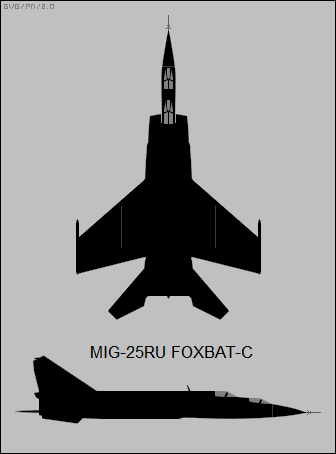
The two trainer variants were very similar externally, and in fact they used the same airframe, with the slightly cranked wing, short tailfins, and short exhausts of Foxbat interceptor variants. Both were given the NATO reporting name of "Foxbat-C". They differed in having optimized equipment fits for their respective training roles:
The MiG-25PU was the first Foxbat trainer to be built, with initial rollout in 1968. The MiG-25PU was also flown on weather reconnaissance missions and apparently got a lot of use, possibly because it was regarded as an economical way to keep up flight hours.
A standard MiG-25PU was used in 1977 to set a number of women's aircraft speed and altitude records. It was given the cover designation of "Ye-133". The pilot was the remarkable Svetlana Savitskaya, who had won the women's world aerobatics crown; set a record free-fall parachute jump; and would go on two space missions to Soviet space stations, becoming the second woman in space, and the first woman to perform a spacewalk.
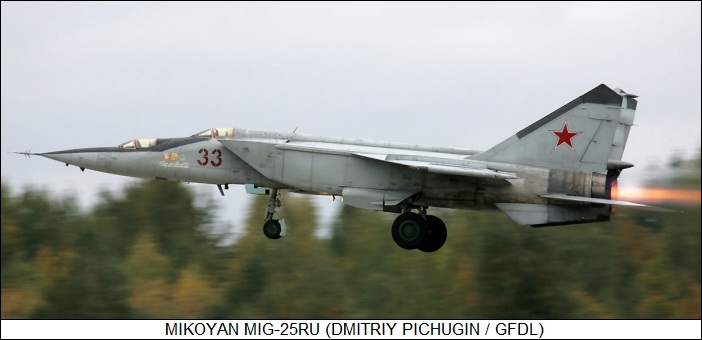
* There were a number of special modifications and minor variants of the MiG-25 series:
* After the fall of the USSR in 1991, Foxbats ended up in the hands of many of the Soviet successor states, including Azerbaijan, Belorussia, Kazakhstan, and Ukraine. The Foxbat was also exported to a number of foreign states, after Belenko's defection made security concerns less relevant. Export MiG-25 interceptors were typically MiG-25PDs fitted to a downgraded avionics standard, usually with the IRST but with the older Smerch radar. These export machines are referred to as "MiG-25PDs" here and are usually described as "Foxbat-Es" in the West, but that is a bit of a simplification.
In any case, export Foxbat users are listed below. Quantities of aircraft delivered tend to be uncertain, and the values given below should be regarded as approximate:
* A total of 1,190 MiG-25s of all types was built from 1969 to 1984, with all except a handful of prototypes built by the factory in Gorkiy. The last, reconnaissance machines, were retired from Russian service in late 2013. Although antiquated, at the time the Russians had nothing of similar capability to replace them.
BACK_TO_TOP